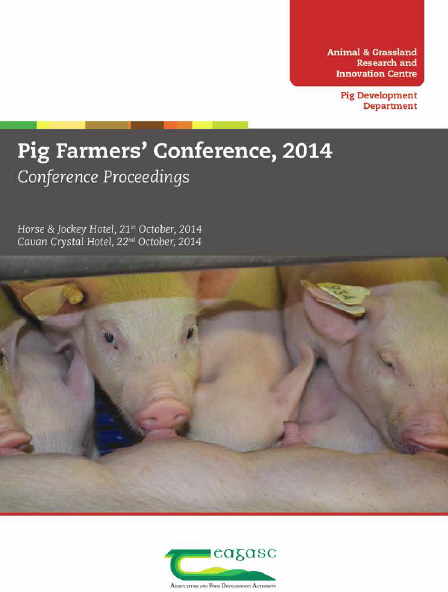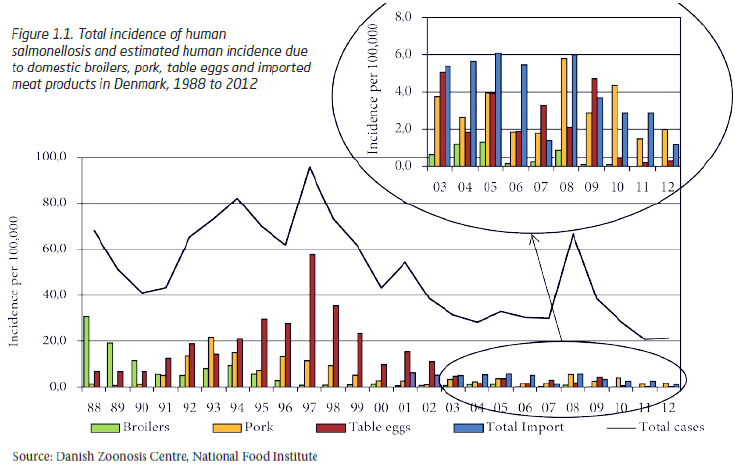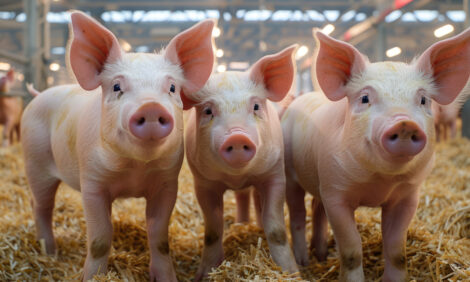



Salmonella Reduction in Pig Herds and Pork: The Danish Experience
The success of the Danish programme is more due to improved slaughter hygiene than to reductions in primary production although more Salmonella in herds makes it more difficult for the slaughter house, according to Jan Dahl, DVM, Chief adviser with the Danish Agriculture & Food Council. He was addressing the 2014 Teagasc Pig Farmers Conference.
Results of the Danish Salmonella Programme for Pigs and Pork
The Danish Salmonella programme for pigs and pork started in the late 1990s. A large research programme was initiated from the beginning, and research has continued until today. Over that long period, many things have changed, and new knowledge has been incorporated.
Overall the results have been good. The number of human cases attributable to Danish pork has dropped from 22 out of 100,000 Danes to two out of 100,000 annually, a reduction of 90 per cent (Figure 1.1)
So overall the programme has been effective. However, a programme like this is made up of many parts, and not all parts have been equally successful. Salmonella surveillance is ongoing in nucleus herds, gilt-producing herds, sow herds, finisher herds and at the slaughterhouse.
Going backwards from the slaughterhouse, the proportion of salmonella-positive carcasses has been reduced from 1.7 per cent in 2001 to less than one per cent in the first half of 2014. But probably more important, the most problematic Salmonella-type, Typhimurium, has been reduced even more.
But epidemiological analyses showed that although the number of high prevalence herds (level 2 and 3 herds in the Danish programme) has been relatively constant between t2 anwo and three per cent in level 2 and one to two per cent in level 3, the number of herds with a few positive samples has gone up. So the conclusion is that the number of positive herds has increased from approximately 30 per cent in 1998 to 60 per cent in 2011. In conclusion: Although the majority of the herds continue to have a low prevalence despite Danish efforts, Salmonella has been spreading between herds.
Improved hygiene in the slaughterhouse has been able to counterbalance the increase in primary production. But it is not possible to point out one particular intervention in the slaughterhouse as the most important factor.

Role of Buying-in Pigs or Gilts
Realising the continued spread of salmonella between herds prompted research into understanding the transfer of Salmonella from nucleus herd to sow herds and from sow herds to finisher herds. From the start of the programme, the general belief was, that buying gilts from a nucleus herds with a high prevalence was more problematic for a sow herd than buying from a low-prevalence nucleus herd. But epidemiological evidence showed that even low-prevalence nucleus herds could infect sow herds, when the sow herd brought in gilts.
The same relationship was found between sow herds and finisher herds. A low prevalence, but positive sow herd – especially if it was positive for Salmonella Typhimurium – constituted the same risk for the finisher herd as a high prevalence sow herd.
Based on this a new declaration system was initiated. Nucleus herds and sow herds that are positive for Typhimurium, Derby and Infantis are declared as Category C herds at risk of transferring Salmonella to sow herds or finisher herds. Herds infected with other serotypes of less significance are declared as Category B herds, with a lower probability of causing problems for the buyer. A herds are herds without any indication of Salmonella being present.
Approximately 35 per cent of nucleus herds and sow herds are Category C herds, and a few percent are Category B herds. The declaration can be found on a homepage, open to the public, so buyers have easy access to all information on the salmonella status of the herd.
Risk Factors for Salmonella in Primary Production
Recent studies have shown that risk factors for salmonella in pig herds should be divided up into risk factors for introduction and risk factors for high salmonella-prevalence in positive herds.
Buying in pigs, contaminated feed, rodents, birds and other vectors can introduce salmonella, but other factors will determine whether it becomes a high prevalence herd.
Physical Form of Finisher Feed: Pellets versus Mash/Meal, Crude versus Fine
Epidemiological investigations showed that herds using pelleted, purchased feed on average had a three times higher per cent positive samples, compared to herds that used home-mixed meal.
This result was somewhat surprising since pelleted feed is Salmonella-controlled, and regular investigations from the Danish Plant Directorate show that the level of Salmonella in Danish pelleted feed is very low, and the few positive samples are almost all serotypes, that are rarely found in Danish pig herds. Home-mixed meal, in contrast, is often based on non-heat-treated material (soybeans), where Salmonella is found regularly.
The results on pelleted feed and meal were confirmed and further investigated in several clinical trials. Feeding non-heat treated, non-pelleted feed to finishers had a protective effect compared to feeding pelleted, heat-treated feed in a herd infected with S. Typhimurium but pigs fed non-pelleted feed had a lower daily growth rate and reduced feed efficiency by approximately five per cent.
Home-mixed feed and coarse ground feed protected against salmonella compared to pelleted feed and fine ground feed.
In an intervention study it was shown, that herds using pelleted feed and having a high Salmonella seroprevalence could reduce the prevalence by mixing 25 per cent of non-heat treated, non-pelleted wheat or barley to the diet, compared to herds only using hygiene and management as interventions.
The mechanism has been investigated. Salmonella reducing feeding principles will increase the number of lactobacilli in the gut, reduce coliforms, including Salmonella and increase bacterial production of organic acids.
Barley/wheat for Finishers
Increasing the amount of barley has a protective effect compared to wheat-based diets.
Growth and feed efficiency were only moderately affected, showing a tendency towards better results with wheat-based diets.
Organic Acids for Finishers
The use of 0.4 per cent organic acids in dry, pelleted feed could reduce the seroprevalence in finishers. Other clinical trials showed that 0.8 per cent formic acid or lactic acid could reduce the Salmonella prevalence in finishers and that the same effect could be obtained by mixing organic acids in drinking water.
Other organic acids have not been investigated thoroughly but could also have a potential.
Liquid Feed for Finishers
The epidemiological investigations showed that herds using liquid feed had a three times lower seroprevalence compared to herds using dry feed.
The fermentation process in many liquid feed systems will reduce the pH and increase the content of organic acids, thereby limiting salmonella in the feed.
The organic acids will probably also increase the pig’s resistance to Salmonella infection. Herds using liquid feed for finishers rarely have high Salmonella seroprevalences. The author has visited several herds with a high seroprevalence and liquid feed. These herds all had a pH in the liquid feed above 5.5. Although it has not been scientifically validated, it is recommended to try to start a fermentation process in the liquid feed in these herds, or to add formic acid to the feed. Generally we recommend achieving a pH below 4.5 in the liquid feed.
Effect of Feed Factors in Sows and Weaners
Use of pelleted feed for sows and weaners was a risk factor for isolating Salmonella from pen faecal samples from weaners. Use of organic acids in sow diets changed the gut flora in a direction similar to what happens in finishers.
Unfortunately, the effect in weaners and sows has been less pronounced than in finishers, and it has not been possible to reduce the level to near zero.
Overall it has been concluded, that sow herds positive for S. Typhimurium stay positive.
Role of Management and Hygiene
Early research showed that it was possible to remove pigs at weaning from sow herds positive for Salmonella Typhimurium, keep the pigs under commercial but highly controlled conditions until slaughter, without any Salmonella infection.
However, epidemiological studies have not proven that all in-all out alone could reduce the level effectively, and experience from Denmark showed, that although very strict all in-all out could produce batches of pigs without Salmonella in infected herds, the results were unreliable, and often high prevalence batches would be produced alternating with low prevalence batches from the same production system, without any clear explanation.
Sufficient and reliable reduction could only be achieved if hygiene and change of management was combined with feed related interventions changing the gut flora.
Lessons Learnt
- Pigs and pork as a source of human salmonellosis can be reduced by implementing salmonella reducing strategies
- Salmonella reduction in high prevalence herds can be achieved
- Feed interventions are essential in reducing the Salmonella prevalence in high prevalence herds
- Improved hygiene in pig herd is not effective as the only intervention but there is no excuse for bad hygiene
- Eradicating Salmonella from a herd is difficult without depopulation of the herd
- Negative herds should not buy pigs or gilts from positive herds
- The success of the Danish programme is more due to improved slaughter hygiene than to reductions in primary production although more Salmonella in herds makes it more difficult for the slaughter house
- Cost-benefit analysis has shown that slaughterhouse interventions are more cost-effective than on-farm interventions.
Reference
Dahl J. 2014. Salmonella reduction in pig herds and pork: the Danish experience. Proceedings of the Teagasc Pig Farmers' Conference 2014. 21 and 22 October 2014. p48-52.
Further Reading
You can view other papers from the 2014 Teagasc Pig Farmers Conference by clicking here.
February 2015








